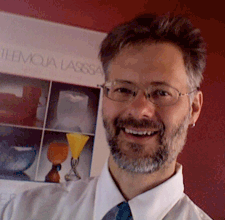Pilgrim Reindeer in Pisa, 1348
a free multimedia novel by
Thomas A. DuBois, University of Wisconsin-Madison
 |
Pilgrim Reindeer in Pisa, 1348 a free multimedia novel by Thomas A. DuBois, University of Wisconsin-Madison |
|
|
|
Part III. Italy. 45. Bruno the Fennus [February 27, 1348]
I enjoyed depicting the guildsmen's quarrel of Buonamico and Boccaccio. Today we regard painters and poets as artists somehow above the lowly title of tradesman, but in the fourteenth century, they were considered craftsmen like other craftsmen: dependent on the wealthy and the Church for commissions and patronage. Buonamico—self-servingly—regards painting as the source of all insights, and thus regards cities as the places where knowledge and sacrality reside. It was in the cities that painters did their work, and pilgrims viewed paintings when they reached the cathedral, shrine, or other pilgrimage destination. Boccaccio the poet is more ready to credit nature and the road with sacral meaning and sides with Bávlos in preferring the countryside to the city. Of course, all of this is my way of suggesting the origins of the Decameron, but it also points up an important question regarding medieval pilgrimage: i.e., whether it is the trek or the destination that is the true heart of the experience. Buonamico the painter sees the destination as the key; Bávlos the wanderer prefers the road. This key difference proves a bone of contention between the two friends in coming chapters.
In this regard, I wanted to include Tacitus's statements about the fenni as an interesting perspective on Sámi life. Tacitus abhors the lifestyle of the fenni yet also finds them alluring: their abject poverty renders them free of the wants and ambitions of the farming Roman. Such is an early inscription of the concept of the noble savage, one which irritates Bávlos because of its distortions of his culture's ways and values. The noble savage construct has dogged Western appraisals of Sámi culture ever since.